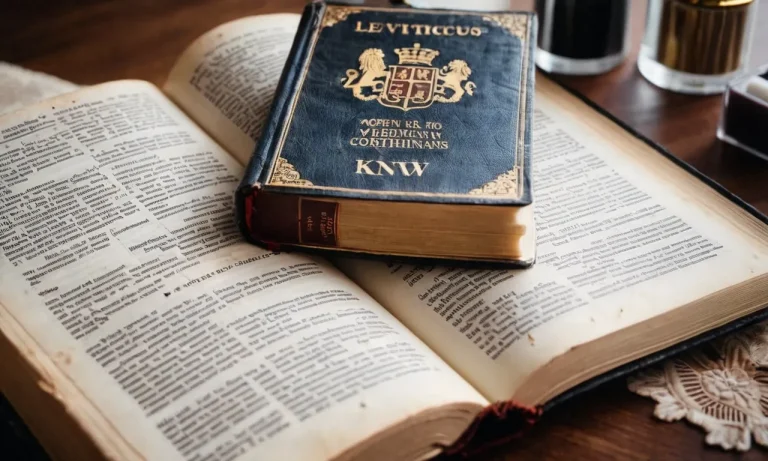How Did The Bible Come Together?
The Bible is revered by billions around the world as the Word of God. But how did this collection of ancient texts from different authors writing in three languages over nearly 1,500 years come to be bound together between two covers?
If you’re short on time, here’s a quick answer to your question: The Bible was formed through a long process involving many authors and editors who were inspired by God to write texts that were eventually canonical and brought together into what we now know as the Bible.
In this comprehensive article, we will explore the complex history behind the formation of the Judeo-Christian scriptures, looking at how the individual books were written, collected, and canonized into the Biblical anthology we read today.
The Composition and Canonization of the Old Testament
The Authorship and Compilation of the Hebrew Bible
The Old Testament is a collection of ancient writings believed to have been written from roughly 1400 BCE to 400 BCE. According to tradition, Moses was the author of the first five books, known as the Torah or Pentateuch.
However, modern scholars believe these books likely had multiple authors and went through stages of editing to reach their final form.
Other Old Testament books like Joshua, Judges, Samuel, and Kings make up a unified history stretching from the conquest of Canaan to the exile of Judah. These historical books are believed to have begun taking shape around 800 – 500 BCE.
Poetic and prophetic books like Psalms, Proverbs, Isaiah, and Jeremiah largely originated from singular gifted authors, but likely also went through stages of compilation. For instance, the book of Psalms contains poems written between 1000-300 BCE.
The process of compiling and editing these books into a canon likely culminated during the later stages of the Babylonian exile and Persian period, from the 6th to the 4th centuries BCE.
The Septuagint: A Greek Translation of the Hebrew Scriptures
The Septuagint was a translation of the Hebrew Bible into Greek, likely for the Jewish community of Alexandria. Tradition holds that seventy scholars created this translation around 250 BCE – amazing! However, it was probably written in stages over a century or more.
This Greek translation “canonized” the Hebrew scriptures outside Israel and served to spread the divine word. It also influenced the vocabulary and theology used in the emerging Christian movement. When early Christian authors quote “scripture,” they often cite the Septuagint translation of the Hebrew Bible.
The Three Stages of the Old Testament Canon
The development of the Old Testament canon can be summarized in three key stages:
- The Torah (first 5 books) received canonical status first around 400 BCE.
- The Prophets gained acceptance next, likely following the mostly completed Septuagint translation around 200 BCE.
- Finally, the Writings, including poetic books like Psalms and Proverbs, became part of the canon by the 2nd century BCE.
| Division | Books | Canonized By |
|---|---|---|
| Torah | Genesis to Deuteronomy | 400 BCE |
| Prophets | Joshua to Malachi | 200 BCE |
| Writings | Psalms, Proverbs, etc. | 2nd Century BCE |
The Authorship of the New Testament
The Four Gospel Accounts of Jesus
The four Gospels – Matthew, Mark, Luke and John – are the main sources of information about the life and teachings of Jesus Christ. Though each has its own perspective, they provide harmonious accounts of Jesus’ ministry, death, and resurrection.
Scholars generally agree the Gospels were written between AD 65-100, with Mark being the first, drawing from the preaching of the apostle Peter. Matthew and Luke drew from Mark’s account, as well as a lost collection of Jesus’ sayings called the Q source.
The physician Luke interviewed eyewitnesses like Mary, Jesus’ mother. John emphasized Jesus’ divine nature and wrote the last around AD 95.
The Book of Acts and the Epistles of Paul and Others
The book of Acts, likely written by Luke as a sequel to his Gospel, documents the early growth of the church, focusing on the ministries of Peter and Paul. Paul wrote letters to encourage churches he established throughout the Roman Empire, like the epistles to the Romans, Corinthians, Galatians, Ephesians and Philippians.
These letters provide sound doctrine and practical guidance for Christian living. Other New Testament letters were written by James, Peter, John and Jude to exhort and instruct early believers. Though written in specific contexts, their timeless principles help Christians today follow Jesus faithfully.
The Later Epistles and Revelation
The later New Testament epistles include the pastoral letters of 1 & 2 Timothy and Titus, where Paul mentors younger leaders on church polity and sound doctrine. Philemon relates a personal appeal to a slave owner, and Hebrews masterfully argues for Christ’s supremacy.
James emphasizes practical faith and wisdom for trials. 1 & 2 Peter offer encouragement to suffering Christians, while the letters of John combat false teaching with truth and love. Jude’s urgent letter calls believers to contend for the faith.
Finally, Revelation unveils apocalyptic visions and prophetic truths about God’s ultimate victory through Jesus.
Though written by over 40 authors over 1500 years, the Bible tells one unified story of God’s love and redemption. This demonstrates the divine inspiration of Scripture. The New Testament continues the Old Testament promise of the Messiah, showing how Jesus fulfilled these prophecies.
God used the authors’ diverse backgrounds and writing styles to convey His message of grace and truth to all people.
How the Early Christian Church Decided What Books to Include
The formation of the Christian biblical canon was a long and complex process that took place over several centuries in the early history of Christianity. Various church councils and leaders met to debate and decide on the canonical status of different books and epistles in circulation at the time.
The Muratorian Canon
One of the earliest known attempts to establish a canon was the Muratorian Canon, an 8th-century Latin manuscript believed to be a copy of a list of canonical texts dated to approximately 170-200 CE. This fragment included most of the New Testament books, affirmed the inspiration of the letters of Paul, denied apostolic authorship or inspiration to several apocryphal works in circulation, and provided the rationale for the authority of the accepted books.
The Canon of Origen
Influential 3rd-century theologian Origen listed the four Gospels, 14 epistles of Paul, 1 Peter, 1 John, and Revelation as accepted books, noting that Hebrews, 2 Peter, 2 and 3 John, James, and Jude were disputed by some.
Origen’s list largely affirmed the core New Testament familiar to most Christians today.
Councils Address Canon Controversies
Later church councils at Hippo Regius in 393 and Carthage in 397 and 419 CE dealt with ongoing controversies surrounding especially the Old Testament canon. They affirmed the Septuagint (Greek translation of the Old Testament) canon with 46 books versus the shorter canon in the Hebrew Masoretic text.
They also affirmed the 27-book New Testament canon as it is known today, indicating its widespread acceptance by this time.
Criteria for Inclusion
Some key criteria used by church leaders to decide whether a text measured up to canonical status included:
- Apostolic origin or connection to the apostles
- Widespread use and citation by early church fathers and councils
- Consistent theological teaching aligned with accepted Christian beliefs
- Existing copies showing no evidence of major variation or change over time
Controversial works that did not meet these standards were rejected. While debate continued for some time, most of the New Testament and Old Testament canons were solidified through these church processes by the late 4th to early 5th centuries CE.
| Date | Event |
|---|---|
| 170-200 CE | Muratorian Canon affirms most NT books |
| 393 CE | Council of Hippo Regius addresses canon issues |
| 397 CE | Council of Carthage establishes NT canon |
The bibles we have today directly descend from these historical decisions made by church authorities regarding the authenticity, reliability, and inspiration of ancient texts. Additional background can be found at History.com.
When the Old and New Testaments were United into One Bible
The process of compiling the books of the Bible into one volume took several centuries. The Old Testament writings were produced over a span of roughly 1,000 years, beginning with Moses’ authorship of the Pentateuch around 1400 BC and ending with the prophetic books in the 400s BC.
The New Testament writings were produced within around a 50 year time frame in the latter half of the first century AD.
In the early years of Christianity, the Old Testament scriptures were read aloud in churches along with the letters and accounts being produced by Jesus’ apostles and their associates. By the late second century AD, early church leaders were referring to the New Testament writings alongside the Old Testament as Scripture.
Still, there was no formally recognized New Testament canon at this point.
In 367 AD, church leader Athanasius in Alexandria, Egypt put forth a list of 27 New Testament books he believed to be authoritative. This list matched the books found in most New Testament manuscripts being reproduced and circulated at the time.
Over the next few decades, church councils met to confirm this 27-book New Testament canon.
The first complete Latin edition of the Bible to include both Old and New Testaments was produced by scholar Jerome in 405 AD. This milestone helped cement the united Old and New Testament canon in the Western church.
Eastern churches recognized the same 27 New Testament books but with minor differences in the Old Testament canon. Still, the basic form of today’s Bible was taking shape across Christendom.
Finally, in 1443 Johannes Gutenberg invented the printing press with movable type. This enabled the mass production of Bibles containing both Old and New Testaments. For the first time ever, average Christians could own and read the complete Bible themselves.
This key development ushered in a new era for the Scriptures coming together in their modern united form.
Conclusion
Over many centuries, the books of the Hebrew Bible and Christian New Testament were written, distributed, evaluated, and formally included in canonical scripture through the inspiration of God and direction of religious authorities.
The result of this long process is the Bible we read today—an anthology of 66 texts from very different historical contexts that nonetheless carry an integrated spiritual message for humanity. The how and why of the Bible’s composition is a key part of understanding and unlocking the meaning of these sacred texts.








